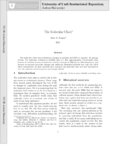Filters: Department: "Anthropology" School Or College: "College of Social & Behavioral Science" Collection: "ir_uspace" Format: "application/pdf"
| Creator | Title | Description | Subject | Date | ||
|---|---|---|---|---|---|---|
| 101 |
 |
Cashdan, Elizabeth A. | Territoriality among human foragers: ecological models and an application to four Bushman Groups | Discussions of human territoriality have become more sophisticated in recent years; we see fewer arguments for or against the adaptiveness of territoriality for mankind in general and more attempts to probe the ecological factors that make territoriality adaptive in particular circumstances. | Foraging; Ecological Models; Bushman | 1983-02 |
| 102 |
 |
Hawkes, Kristen | The derived features of human life history | This chapter compares and contrasts the life histories of extant great apes in order to construct a hypothetical life history of the last common ancestor of all great apes and to identify features of human life history that have been derived during the evolution of our lineage. Data compiled from th... | 2006-01-01 | |
| 103 |
 |
Rogers, Alan R. | The molecular clock | The molecular clock uses evolutionary changes in proteins and DNA to measure the passage of time. Yet molecular evolution is clocklike only to a first approximation. Uncertainties arise because of variation in rates of molecular evolution, because of difficulty in calibrating clocks, and because we ... | 2013-01-01 | |
| 104 |
 |
O'Rourke, Dennis H. | Unangan past and present: the contrasts between observed and inferred histories | Abstract Academic research focusing on the population and culture history of the Aleut (Unangan) people began in the late 19th century and continues to the present. The papers in this special issue of Human Biology summarize the latest results from archaeological, linguistic, genetic, and morphometr... | 2010 | |
| 105 |
 |
Wiessner, Pauline W. | Vines of complexity - egalitarian structures and the institutionalization of inequality among the Enga | The initial stages of the institutionalization of hierarchical social inequalities remain poorly understood. Recent models have added important perspectives to "adaptationist" approaches by centering on the agency of "aggrandizers" who alter egalitarian institutions to suit their own ends through de... | Egalitarian structures; Political evolution; Social d | 2002-04 |
| 106 |
 |
Cashdan, Elizabeth A. | Waist-to hip ratio across cultures: trade-offs between androgen-and estrogen-dependent traits | A gynoid pattern of fat distribution, with small waist and large hips (low waist-to-hip ratio, or WHR) holds significant fitness benefits for women: women with a low WHR of about 0.7 are more fecund, are less prone to chronic disease, and (in most cultures) are considered more attractive. Why, then... | Fertility; Optimum; Fecundity | 2008 |
| 107 |
 |
Cashdan, Elizabeth A. | Waist-to-hip ratio across cultures: trade-offs between androgen- and estrogen-dependent traits | A gynoid pattern of fat distribution, with small waist and large hips (low waist-to-hip ratio, or WHR) holds significant fitness benefits for women: women with a low WHR of about 0.7 are more fecund, are less prone to chronic disease, and (in most cultures) are considered more attractive. Why, then... | Fat distribution; Gynoid pattern; Body types; Waist-to-hip ratio; WHR | 2008 |
| 108 |
 |
Wiessner, Pauline W. | Wealth transmission and inequality among hunter-gatherers | We report quantitative estimates of intergenerational transmission and population-wide inequality for wealth measures in a set of hunter-gatherer populations. Wealth is defined broadly as factors that contribute to individual or household well-being, ranging from embodied forms, such as weight and h... | 2010-02 | |
| 109 |
 |
McElreath, Richard | When natural selection favors imitation of parents | It is commonly assumed that parents are important sources of socially learned behavior and beliefs. However, the empirical evidence that parents are cultural models is ambiguous, and debates continue over their importance. A formal theory that examines the evolution of psychological tendencies to i... | Transmission; Evolution; Culture | 2008 |
| 110 |
 |
Hawkes, Kristen | Why hunter-gatherers work: An ancient version of the problem of public goods | From the abstract: People who hunt and gather for a living share some resources more widely than others. A favored hypothesis to explain the differential sharing is that giving up portions of large, unpredictable resources obligates others to return shares of them later, reducing everyone's variance... | Hunter-gatherer societies; Public goods | 2001-08 |
| 111 |
 |
Cashdan, Elizabeth A. | Why is testosterone associated with divorce in men? | There is evidence that in women high levels of testosterone are associated with more sexual partners and more permissive sexual attitudes. If a similar relationship holds true for men, the higher basal testosterone levels of divorced and unmarried men may be caused by this relationship rather than b... | Marriage; Separation; Hormones; Sexuality | 1998-06 |
